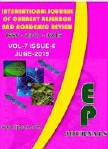Abstract Volume:7 Issue-6 Year-2019 Original Research Articles
 |
Online ISSN : 2347 - 3215 Issues : 12 per year Publisher : Excellent Publishers Email : editorijcret@gmail.com |
The study of GEI has assumed great importance in genotype testing programs because yield performance of a genotype is a result of the interaction between the genotype and environment. The study cried out with objectives to determine the effect of genotype, environment, and GEI on agronomic traits and to identify stable genotype. Fifteen bread wheat genotypes were evaluated by RCBD using four replications at six locations in Ethiopia. Combined analysis of variance showed very highly significant differences (P<0.001) among environments and among genotypes. The GEI was also significant for all agronomic except for tiller number. The Genotype main effect was not significant for grain per spike and tiller number. The significant GEI indicated that performance of the genotypes in agronomic was not consistent over environments; some genotypes performed well at some locations but poorly at other locations. The environments contributed total treatment sum square 80-90% in TILL and BIO, 70-80% in PHT and HI. These traits were determined mainly by the environment. Other yield and yield components contributed 20-60% total sum square of environments. Genotype contributed less than 10% to total treatment sum square in all traits except in GYLD (33.46), HLW (20.4), TKW (38.0) and HI (12.9%). GxE contributed less than 10% to total treatment sum square in BIO. It contributed 10-20% in PHT, TILL and HI, 20-30% in HLW, 30-40% in GYLD, TKW and GNO. The biplot of AMMI revealed clear insight into the specific and general adaptation of genotypes across locations. The AMMI biplot, which accounted for 80.71 PHT, 65.52 TILL, 78.81 GNO, 82.9 BIO, 78.53 HI, 70.1 TKW, 68 HLW and 74.7% GYLD of the GxE interaction, provides the interaction principal component scores of the 1st and 2nd IPCA. High grain yield was harvested from the advanced genotype ETBW9470 and lowest from ETBW8075. The advanced genotype ETBW8427was the tallest genotype and ETBW8078was found to be the shortest plant height. The maximum fertile tiller numbers were obtained from advanced genotype ETBW8070 and minimum tiller number was obtained from the advanced genotype ETBW9464. Advance genotypes ETBW9037 had high number of grain per spike and ETBW8075had low mean number of grains spike-1 over locations. Advanced genotype ETBW8070 had high biomass yield over the location and ETBW8075 had low biomass yield. Maximum harvest index was observed for ETBW9470, while minimum harvest index noticed for ETBW8075.
How to cite this article:
Gadisa Alemu, Ruth Duga and Demeke Zewude. 2019. Stability Performance of Bread Wheat (Triticum aestival L) Genotype for Yield Related Traits.Int.J.Curr.Res.Aca.Rev. 7(6): 89-100doi: https://doi.org/10.20546/ijcrar.2019.706.008



Quick Navigation
- Print Article
- Full Text PDF
- How to Cite this Article
- on Google
- on Google Scholor
- Citation Alert By Google Scholar
